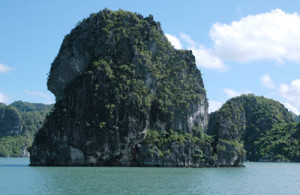Whatsapp : +84985873537
Dau Nguoi Islet
Dau Nguoi Islet (Human head shaped Islet) is situated in the south of the island range of Bo Hon, Halong Bay, about 13 kilometers far from Bai Chay Tourist Wharf. It lies near Luon Grotto, Sung Sot Island and Ti Top Island.


Dau Nguoi Islet is about 25 meters high. The islet is famous for its special shape of a man’s head. From a far position, it looks like the head of a Greek with a big hawkish nose and pointed chin above the water surface. Some thought that it’s like a statue of the Egyptian Sphinx.
The most ideal time to gaze the islet is at the sunset. By kayaking or from the cruise, tourists will see fantastic scenery of Dau Nguoi Islet in red sunshine of late afternoon
About Halong Bays
Ha Long Bay, situated in the Gulf of Tonkin, includes some 1600 islands and islets forming a spectacular seascape of limestone pillars. Because of their precipitous nature, most of the islands are uninhabited and relatively unaffected by human influence.
The geomorphology of Ha Long Bay is known as a drowned karst landscape due to the exceptional combination of its limestone karst features which have been subject to repeated regression and transgression of the sea over geological time. The limestones of Ha Long Bay have been eroded into a mature landscape of fengcong (clusters of conical peaks) and fenglin (isolated tower features) karst features, modified by sea invasion at a later stage.
The smaller islands are fenglin towers of 50m to 100m high with height. Many have vertical walls on all or most sides and these continue to evolve by rock falls and large slab failures.
Marine invasion of Ha Long Bay has added an extra element to the normal process of lateral undercutting of the limestone towers and islands. The most conspicuous feature being the main notch cut into the entire rocky coastline. Notches are a feature of limestone cliffs worldwide, but those of Ha Long Bay are exceptionally well developed and, at many sites, extend into arches and caves. This process of undercutting and subsequent erosion maintains the steep faces of the fenglin karst towers and thereby perpetuates the spectacular nature of the landscape.
A distinctive feature of Ha Long Bay is the abundance of lakes within the larger limestone islands.
Extensive limestone caves represent another important feature of Ha Long Bay, with three main types able to be identified: old phreatic caves formed below the water table of the time; old karstic foot caves formed by lateral undercutting of cliffs at base level; and marine notch caves formed at sea level where rock structures are powerfully eroded and eventually reduced to a wave cut platform.
In summary, Ha Long Bay possesses a tremendous diversity of caves and other landforms which derive from the unusual geomorphological process of marine invaded tower karst. These areas provide a unique and extensive reservoir of data for the future understanding of geoclimatic history and the nature of karst processes in a complex environment.







